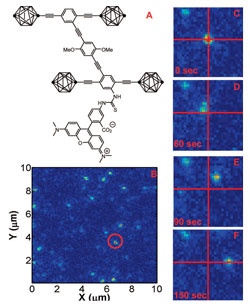Feb 2 2009
The drivers of Rice University's nanocars were surprised to find modified versions of their creation have the ability to roll at room temperature. While practical applications for the tiny machines may be years away, the breakthrough suggests they'll be easier to adapt to a wider range of uses than the originals, which had to be heated to 200 degrees Celsius before they could move across a surface.
 Time-lapsed photography of the circled zone in the 10-by-10 micron field at left yielded the series of photos at right. These show the movement of a fluorescent-tagged nanocar over 150 seconds. At top left is the chemical structure of the nanocar, with its carborane wheels and dye trailer.
Time-lapsed photography of the circled zone in the 10-by-10 micron field at left yielded the series of photos at right. These show the movement of a fluorescent-tagged nanocar over 150 seconds. At top left is the chemical structure of the nanocar, with its carborane wheels and dye trailer.
The nanocar was a sensation when introduced in 2005 by the lab of James Tour, Rice's Chao Professor of Chemistry and a professor of mechanical engineering and materials science and computer science.
Tour's original single-molecule car had buckyball wheels and flexible axles, and it served as a proof-of-concept for the manufacture of machines at the nanoscale. A light-activated paddlewheel motor was later attached to propel it, and the wheels were changed from buckyballs to carboranes. These were easier to synthesize and permitted the motor to move, because the buckyball wheels trapped the light energy that served as fuel before the motor could turn. Since then, nanotrucks, nanobackhoes and other models have been added to the Rice showroom.
A large-scale representation of the nanocar made its public debut in Houston's famous Art Car Parade last year.
Rice's Stephan Link, an assistant professor of chemistry who specializes in plasmonics, took the wheel for a new series of experiments that built upon Tour's pioneering work. Link's primary achievement was using single-molecule fluorescence imaging to track the tiny vehicles, as opposed to the scanning tunneling microscopy (STM) used in earlier experiments. STM imaging can capture matter at an atomic scale, but the technique requires the target to be on a conductive substrate. Not so with fluorescent imaging.
A paper on the new research published this month in ACS Nano was authored by Link; Tour; Anatoly Kolomeisky, associate professor of chemistry and chemical and biomolecular engineering; postdoc Guillaume Vives; graduate students Saumyakanti Khatua and Jason M. Guerrero; and undergraduate Kevin Claytor.
"We thought, 'We're just going to take an image, and nothing's going to happen,'" said Link of the team's initial success in attaching fluorescent dye trailers to the nanocars. "We were worrying about how to build a temperature stage around it and how to heat it and how to make it move.
"To my surprise, my students came back and said, 'They moved!'"
Sure enough, time-lapsed films monitoring an area 10-by-10 microns square showed the cars, which appear as fluorescing dots, zigging and zagging on a standard glass slide. Link said the cars moved an average 4.1 nanometers (or two nanocar lengths) per second.
"It took us another year to quantify it," said Link, noting as key the development of a new tracking algorithm by Claytor that will be the subject of a future paper.
The simplest technique for finding moving nanocars was precisely the way astronomers find distant cosmic bodies: Look at a series of images, and the dots that move are winners. The ones that don't are either fluorescing molecules sitting by themselves or nanocars stuck in park.
The dye - tetramethylrhodamine isothiocyanate - had the added attraction of emitting a polarized signal. Since dye molecules tended to line up with the chassis, the researchers could always tell which way the cars were pointed.
Link hoped cars with dye embedded into the chassis can be built that would eliminate the drag created by the fluorescent trailer. He speculated that putting six wheels instead of four on a nanocar could also help keep it moving in one direction, much like a tank with treads.
"Now that we see movement, the challenge is to take it to the next level and make it go from point A to point B. That's not going to be easy." Creating nanotracks or roads may be part of the solution, Link said.
All the research is directed at the ultimate goal of building machines from the bottom up in much the same way proteins are built to carry out tasks in nature.
"In terms of computing, having these single molecules be addressable is a goal everybody wants to reach," said Link. "And to understand and emulate biophysics and biomechanics, to build a device based on what nature gives us, is of course one of the dreams of nanotechnology."